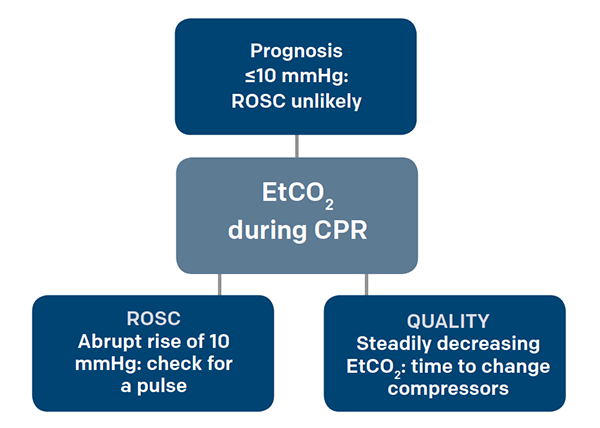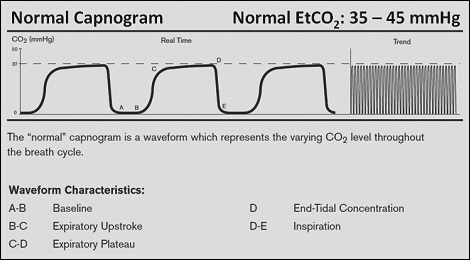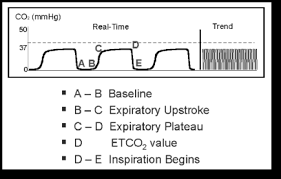end tidal co2 range cpr
In the field monitoring ETco 2 during endotracheal-tube placement can verify correct tube placement and indicate tube dislodgement during transport. Although certain ETCO2 cut-off values appears to be a strong predictor of mortality the utility of ETCO2 cut-off values during CPR to accurately predict the outcome of resuscitation is.

Reversible Causes Of Low Etco2 In Cpr Criticalcarenow
Waveform capnography represents the amount of carbon dioxide CO2 in exhaled air which assesses ventilation.

. In the ED we typically think of a EtCO2 as a marker of perfusion and ventilation. Normal ETCO2 is in the range of 35 to 45 mmHg. S Thompson A.
End-tidal CO2 EtCO2 monitoring is a noninvasive technique which measures the partial pressure or maximal concentration of carbon dioxide CO2 at the end of an exhaled breath which is expressed as a percentage of CO2 or mmHg. Association between prehospital cpr quality and end-tidal carbon dioxide levels in out-of-hospital cardiac arrest. Murphy RA Bobrow BJ Spaite DW et al.
Measurement of a low ETCO 2 value. Monitoring of end-tidal carbon dioxide EtCO2 is a noninvasive method that measures the partial pressure or maximal concentration of carbon dioxide CO2 at the end of exhaled breath which is expressed as a percentage of CO2. What Is End Tidal Co2 Range.
Between 3540 mmHg A normal EtCO2 is considered between 3540 mmHg however results may be influenced by various physiological factors. NaHC03 will increase EtCO2 because it splits into CO2 and H20 So if rises after NaHCO3 do not misinterpret as ROSC. The waveform is called capnograph and shows how much CO 2 is present at each phase of the respiratory cycle.
What does low ETCO2 mean. During cardiopulmonary resuscitation CPR adequate chest compressions generate a cardiac output of 17 to 27 allowing CO 2 circulation for exhalation. 428 153 mmHg versus 323 141 mmHg.
Current guidance recommends an end- tidal carbon dioxide ETCO2 of 4045 kPa 300 338 mm Hg to achieve a low- normal arterial partial pressure of CO2 PaCO2 and reduce secondary brain injury. ETCO2 values during CPR do correlate with the likelihood of ROSC and survival and therefore have prognostic value. PaCO2 PetCO2 End tidal measurement from expired or exhaled air PaCO2 Arterial blood gas sample End tidal normally 2-5 mmHg lower than arterial Comparing Arterial and End-tidal CO2 Review of Airway Confirmation Visualization Auscultation.
End tidal co2 range cpr Tuesday March 15 2022 Edit Properly administered capnography can help to identify lower end tidal CO 2 EtCO 2 levels so that appropriate changes in CPR such as rate or force of compression can take place. These levels of CO 2 were consistent with effective chest compression generating reasonable pulmonary blood flow justifying continuation of resuscitation. Capnography measures the amount of CO2 present at the end of exhalation end-tidal CO2 or ETCO2 displays a waveform that represents air movement through the.
423 20 mmHg versus 34 255 mmHg. What should end tidal CO2 be kPa. The height of the ETCO2 waveform during CPR has been used as an indirect measure of adequate chest compressions helping those involved in resuscitation monitor the effectiveness of their compressions in real time.
In the awake adult normal cardiac index lies between 25-4 Lminm2 with an ETCO2 of 35-45 mmHg. This is an example of capnography during CPR. In normal conditions CO2 is 5 to 6 which is equivalent to 35-45 mmHg.
It consists of a number and a graph. End-tidal CO2 EtCO2 monitoring is a measure of metabolism perfusion and ventilation. This is end-tidal CO2 ETCO2 which is normally 35-45 mm Hg.
Two very practical uses of waveform capnography in CPR are. Negative Epigastric sounds Equal lung sounds Esophageal detector. 2 USES DURING CPR 7 CONFIRM ADEQUACY OF CHEST COMPRESSIONS.
The number is called capnometry which is the partial pressure of CO 2 detected at the end of exhalation ranging between 35 - 45 mm Hg or 40 57 kPa. MEASURING END-TIDAL CO 2 LEVELS DURING CARDIAC ARREST. 1 evaluating the effectiveness of chest compressions and 2 identification of ROSC.
End-tidal carbon dioxide ETCO 2 monitoring is readily available easily used and a standard of care in the operating suite and in the critical care setting. Cardio Pulmonary Resuscitation CPR ETCO2 concentration is a reliable index of effective heart compression during CPR which is associated with cardiac output 7 8. The normal values are 5 to 6 CO2 which is equivalent to 35-45 mmHg.
The number is capnometry which is the partial pressure of CO2 detected at the end of exhalation. End tidal CO 2 monitoring is represented as a number and a graph on a monitor. To identify whether any level of end-tidal carbon dioxide ETCO2 measured during cardiopulmonary resuscitation CPR correlates with return of spontaneous circulation ROSC or survival in adults experiencing cardiac arrest in any setting.
The first sign of the return of spontaneous circulation ROSC during CPR is increase in ETCO2 therefore monitoring of ETCO2 provides very useful information to guide treatment during CPR 8 - 10. In mmHg the PetCO2 values for those with and without ROSC after five minutes of CPR was. In normal conditions CO2 is 5 to 6 which is equivalent to 35-45 mmHg.
Throughout the resuscitation end-tidal CO 2 was consistently in the 28-36 mmHg range during VFCPR. End-tidal CO 2 et CO 2 monitoring is not a new modality in the pediatric emergency department PED and emergency department. Monitoring of end-tidal carbon dioxide EtCO2 is a noninvasive method that measures the partial pressure or maximal concentration of carbon dioxide CO2 at the end of exhaled breath which is expressed as a percentage of CO2.
What is normal PETCO2. Normal ETCO2 in the adult patient should be 35-45 mmHg. We included randomized controlled trials cohort studies and case-control studies of adult cardiac.
4 to 5 CO2 PetCO2 vs. When a capnometer is available and the machine is warmed-up connection to the ventilatory circuit takes CPR whether ventilating via bag-mask laryngeal. However EtCO2 is an extremely powerful surrogate for endotracheal tube ETT P osition CPR Q uality R eturn.
What is the normal range of end tidal CO2. End-Tidal CO2 in Cardiopulmonary Resuscitation. This will cause a decrease in the ETCO2 end-tidal CO2 and this will be observable on the waveform as well as with the numerical measurement.

Waveform Capnography In The Intubated Patient Emcrit Project

Pv Card Continuous End Tidal Co2 Monitoring In Cardiac Arrest Cardiac Arrest Cardiac Nursing Medical Knowledge

Average Etco2 Kpa During Cpr In Patients With Or Without Rosc Download Scientific Diagram

Capnography Provides Bigger Physiological Picture To Maximize Patient Care Jems Ems Emergency Medical Services Training Paramedic Emt News

Etco2 Valuable Vital Sign To Assess Perfusion The Airway Jedi

Waveform Capnography In The Intubated Patient Emcrit Project

Use End Tidal Capnography For Placing Orogastric Nasogastric Tubes And Cpr Page 2 Of 4 Acep Now Page 2

3 Waveform Capnography Showing Changes In The End Tidal Carbon Dioxide Download Scientific Diagram

Capnography During Cardiopulmonary Resuscitation Current Evidence And Future Directions

Capnography Provides Bigger Physiological Picture To Maximize Patient Care Jems Ems Emergency Medical Services Training Paramedic Emt News

3 Waveform Capnography Showing Changes In The End Tidal Carbon Dioxide Download Scientific Diagram

The Impact Of Ventilation Rate On End Tidal Carbon Dioxide Level During Manual Cardiopulmonary Resuscitation Resuscitation
Emdocs Net Emergency Medicine Educationcapnography In The Ed Emdocs Net Emergency Medicine Education

Quantitative Waveform Capnography Acls Medical Training

The Role Of Etco2 In Termination Of Resuscitation Jems Ems Emergency Medical Services Training Paramedic Emt News

Capnogram R Series Defibrillator Zoll Medical Uk

Average Etco2 Kpa During Cpr In Patients With Or Without Rosc Download Scientific Diagram

Sar Helicopter Paramedic Practice Etco2 Measuring To Assist With Cpr Attempts Journal Of Paramedic Practice
